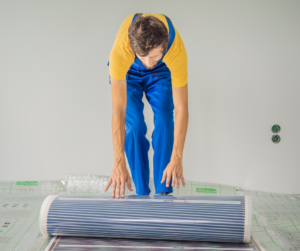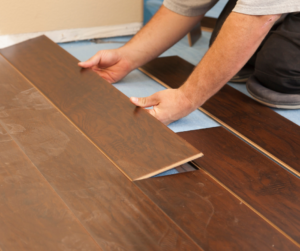Vinyl or hardwood is a choice many homeowners have to make. Vinyl plank flooring is a favorite among homeowners who want the look and texture of natural wood or stone without the financial investment. It’s durable, waterproof, and a great fit for families with kids and pets. Good vinyl plank flooring has the color all the way through the planks so scratches aren’t easily visible. But if you’re replacing your floors with an eye toward resale, it’s important to know that vinyl plank flooring won’t charm every buyer – particularly if it is not top of the line. Understand your market and potential buyers to decide if vinyl plank flooring is the best upgrade for your soon-to-be-sold space.
Vinyl Plank Flooring Explained
Vinyl plank flooring is a type of hard flooring made from layers of polyvinyl chloride (PVC). PVC is a plastic polymer that forms the core material of vinyl planks—it provides stability, durability, and waterproofing.The top layer is the wear layer, followed by printed or embossed design layers, a core layer, and a backing layer. Vinyl plank flooring is designed to look like hardwood planks, stone, or other natural materials—but requires a substantially lower cost investment. Typically vinyl plank flooring is $3 to $5 less per square foot than hardwood floors.
 Putting new floors in your home can be a time-consuming and costly renovation process, which is why it’s important to choose the best flooring type for your lifestyle. While hardwood has been a timeless option for decades, there are many affordable alternative flooring options like vinyl plank flooring that are known for being just as beautiful.
Putting new floors in your home can be a time-consuming and costly renovation process, which is why it’s important to choose the best flooring type for your lifestyle. While hardwood has been a timeless option for decades, there are many affordable alternative flooring options like vinyl plank flooring that are known for being just as beautiful.
Vinyl plank flooring isn’t just popular because it costs less than natural materials. Homeowners choose it for its durability and for the ease with which it holds up in high-traffic or wet areas. Vinyl is naturally waterproof and can handle moisture, which makes it a great option for basements, kitchens, mudrooms, bathrooms, or any area prone to water exposure.
–
Vinyl plank flooring is easy to install – eveb for beginner DIYers and homeowners investing in a major makeover. The installation depends on the type of flooring being installed. Some types can be installed via peel-and-stick backing while others are glued down, or clicked together.
Why Choose Vinyl Plank Flooring
 If your home includes old carpet, damaged tile, or ugly linoleum, you may want to install new flooring. Do you choose vinyl or hardwood?
If your home includes old carpet, damaged tile, or ugly linoleum, you may want to install new flooring. Do you choose vinyl or hardwood?
Vinyl plank flooring often offers more soundproofing than hardwood, so it works well for active homeowners. If you live in a high-rise condo and you are considering vinyl or hardwood, some vinyl flooring products may make a better choice because they come with an acoustic backing that enhances sound insulation, reducing and absorbing sound. It’s also soft underfoot compared to harder materials like tile or hardwood so it’s great for kitchens and home gyms.
The choice of vinyl or hardwood frequently is affected by whether you have small children or pets. Vinyl plank flooring is very durable and easy to clean, but now more buyers are choosing vinyl because they love the look and feel. In the past, buyers have associated luxury and value with solid wood floors but the trend is changing since there are so many color and texture options.”
Why You Should Choose Hardwood Flooring
If you’re debating between installing vinyl or hardwood, natural wood has multiple benefits when it comes to selling your home. Simply said, many buyers expect to have hardwood floors in their new home along with the granite counters, marble bath tiles and stainless kitchen appliances.
When considering vinyl or hardwood, you should look at whether the comparable homes in your market are filled with hardwood floors, vinyl plank flooring can set your home apart—but not always in a good way. In that case, you might want to limit your use of vinyl plank flooring to areas of the home that will benefit by its waterproof feature, such as a laundry room or a mud room.
Hardwood costs more up front, but it has an extended lifespan that makes it a once-in-a-lifetime investment. While vinyl flooring initially is typically less expensive, hardwood flooring can add more value to a home and has a longer lifespan, which can make it a more cost-effective choice in the long run, Additionally, hardwood can be refinished multiple times, extending its life and maintaining its appearance.
Ultimately, it is a matter of indvidual choice – vinyl or hardwood. For some, even the best vinyl plank flooring doesn’t measure up to the warmth and texture of natural materials. Vinyl can mimic the look of natural materials, however for those buyers it does not provide the same tactile experience as genuine hardwood or stone.
Types of Hardwood to Choose
There are several types of hardwood floors to choose from in your home: solid wood, parquet, engineered, and laminate. While they may look similar, each one is made differently—amd some aren’t true wood at all.
Solid Wood
This type can be everything from strip to plank flooring that is cut entirely from one solid piece of wood. With solid wood flooring, no other material is incorporated and it can be sanded or re-finished multiple times. Many hardwood floors last 100-plus years. While solid wood is durable, it is a natural material, so it can succumb to water damage or environmental changes (particularly if it’s not correctly finished).
Parquet
Parquet uses smaller pieces of solid wood to form a floor pattern. Because it is real, solid wood, it generally performs the same as a plank wood floor. It can be refinished or sanded and has a long lifespan.
Engineered
Engineered wood is durable, but not as durable as solid wood; it can also be damaged by water and wear. Engineered flooring consists of several different plies of wood glued together with the grains running in different directions. The surface consists of a wear layer that can typically be sanded, but only a few times. The top level or wear layer of engineered floor should be at least 3/16 inches thick, providing enough thickness for one to two full sandings if needed.
Laminate
Laminate floors are made of a synthetic material—not true wood. This type is also usually created with a core board with by a melamine wear layer on top.
